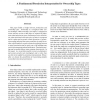Free Online Productivity Tools
i2Speak
i2Symbol
i2OCR
iTex2Img
iWeb2Print
iWeb2Shot
i2Type
iPdf2Split
iPdf2Merge
i2Bopomofo
i2Arabic
i2Style
i2Image
i2PDF
iLatex2Rtf
Sci2ools
TASE
2008
IEEE
2008
IEEE
A Fundamental Permission Interpretation for Ownership Types
This paper builds a bridge between permissions and ownership types. Ownership is a recognized alias control technique. With ownership, each object is assigned an owner and any access to that object is required to follow some rules based on its owner. Permission is a low-level linear value associated with some piece of state in a program and it is often used to permit certain operations. A permission nesting indicates that some permission is nested in another which intuitively reveals a protection relation between a nested permission and its nester one, with building some restriction among operations furthermore. Permission nesting and ownership behave some common characteristic. In this paper, two ownership models (owners-as-dominators and owners-as-locks) are investigated, and we show they are able to be unified by permission interpretation. Whereafter, we discuss the possibilities of representing multiple ownership by fractional permissions.
| Added | 01 Jun 2010 |
| Updated | 01 Jun 2010 |
| Type | Conference |
| Year | 2008 |
| Where | TASE |
| Authors | Yang Zhao, John Boyland |
Comments (0)

